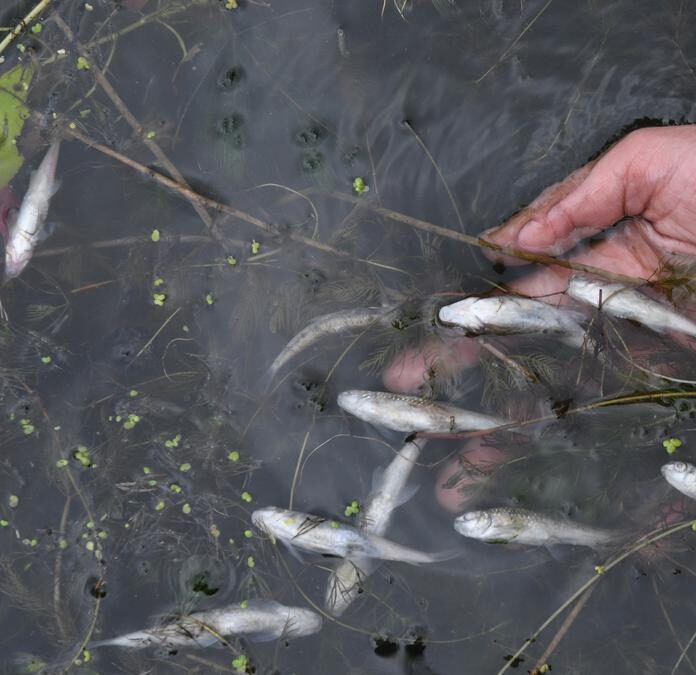Kashmir Valley is known for its beautiful lakes all around the world. One of the lakes which is considered a gem lake in Kashmir is Dal Lake. The lake is surrounded by beautiful Zabarwan mountains and is one of the finest lakes in the world. However, the serene nature of this iconic lake has recently been shattered by a disturbing phenomenon. The unexplained and widespread mortality of fish in Dal Lake has sent shockwaves through the region, leaving experts and authorities scratching their heads and determined to uncover the truth. Here, we will try to unravel the mysteries surrounding this ecological crisis. By getting into the potential causes behind the fish deaths and examining the far-reaching implications for both the environment and the local community, we aim to shed light on the urgency and significance of this issue. Such incidents risk the future of Dal Lake, and it is crucial that we comprehend the magnitude of the challenges faced in order to pave the way toward effective solutions and safeguard the ecological harmony of this cherished natural wonder.
The Concerning Fish Mortality
The sudden and alarming death of fish in Dal Lake has triggered a wave of distress and concern among the local community and environmental experts alike. The unexpected and unexplained mass mortality of such a significant number of fish in the lake has raised serious questions about the underlying cause, leaving everyone worried.
In response to this ecological crisis, the court has taken a proactive stance, acknowledging the urgency of the situation and the need for a comprehensive understanding of the problem. To shed light on the matter, the court has directed the Pollution Control Board, Srinagar, to conduct an in-depth investigation and submit a detailed report on the quality of water and oxygen content in the lake.
This judicial directive emphasizes the crucial importance of analyzing the various environmental factors at play in Dal Lake, including water quality and oxygen levels. By examining these elements, experts hope to identify any potential contributors to the mass fish deaths and formulate effective strategies to address the underlying issues. The court’s intervention signifies the seriousness of the issue and thrusts for immediate action to protect the fragile ecosystem of Dal Lake.
Potential Causes of Fish Mortality
The mass fish deaths in Dal Lake have prompted experts and authorities to propose various theories in an attempt to understand the cause of this ecological crisis. One leading hypothesis that has been put forward is thermal stratification. Officials responsible for maintaining the lake explain that thermal stratification occurs when different layers of water with varying temperatures form within the lake. This phenomenon can result in a depletion of oxygen in the deeper layers, leading to suffocation and the subsequent death of aquatic life.
A similar case of mass dead fish washup was recently observed on the Texas Gulf Coast, where thousands of fish were killed and washed up on the sand. Experts in the Texas Gulf have some sort of opinion on what has led to the fish kill. They believe it is also due to higher water temperatures which lead to depletion of oxygen in the water.
While thermal stratification is considered a potential factor, it is essential to explore other possible causes as well. Pollution emerges as a significant concern in relation to the deteriorating health of Dal Lake’s ecosystem. Experts attribute the lake’s pollution levels to industrial waste, untreated sewage, and the excessive use of fertilizers and pesticides in the surrounding areas. These pollutants have a profound impact on the quality of water in the lake, leading to a decline in oxygen levels and posing a serious threat to the survival of aquatic organisms.
The interplay between thermal stratification and pollution highlights the complex nature of the issue at hand. A comprehensive investigation is necessary to assess the extent to which each factor contributes to the mass fish deaths in Dal Lake. This multidimensional approach is crucial in order to devise effective mitigation measures and restore the ecological balance of the lake.
The Impact on Ecosystem and Human Livelihoods
The death of fish in Dal Lake not only has immediate consequences for the lake’s ecosystem but also carries long-term implications for the local community. Fish play a crucial role in maintaining the delicate balance of the lake’s food chain, and their loss disrupts the complex web of interactions within the ecosystem. With the depletion of fish populations, other species that depend on fish as a food source may struggle to survive, leading to a ripple effect throughout the entire ecosystem. This ecological imbalance poses a significant risk of biodiversity loss and further affects the fragile state of Dal Lake.
Furthermore, the local economy heavily relies on the lake for both tourism and fishing activities. Dal Lake’s beauty and diverse aquatic life attract a considerable number of visitors each year, contributing significantly to the region’s tourism revenue. However, the recent fish deaths can tarnish the lake’s reputation and discourage potential tourists from visiting, resulting in a decline in revenue for local businesses. Similarly, the fishing industry, which serves as a vital source of livelihood for many residents, may suffer severe economic setbacks due to the diminishing fish populations. The loss of fish not only impacts the ecological integrity of Dal Lake but also affects the economic well-being of the local community, emphasizing the urgent need for conservation and sustainable management strategies.
The High Court’s Directive
In response to the distressing phenomenon, the Jammu and Kashmir High Court has taken a proactive stance. Chief Justice N Kotiswar Singh and Moksha Khajuria Kazmi, while hearing a public interest litigation (PIL) on the preservation of Dal Lake, directed the government to proceed with the modification of the Master Plan 2035. The court emphasized the importance of following due process as stipulated by the Jammu and Kashmir Development Act 1970.
Furthermore, the bench acknowledged the seriousness of the situation and ordered the Director of Fisheries, Kashmir, to investigate the mass fish deaths. The court sought a prompt examination to determine the cause of the fish mortality and requested a detailed report on the matter. This proactive approach by the court highlights the severity of the situation and the need for urgent action.
The Need for Immediate Action
In light of the far-reaching consequences of fish mortality in Dal Lake, urgent and decisive action is needed. The court’s directive to modify the Master Plan 2035 demonstrates a clear commitment to rectifying the situation and ensuring the long-term sustainability of the lake. However, it is important to recognize that modifying the Master Plan alone will not suffice in addressing the multifaceted issues at hand.
Efforts must be focused on identifying and mitigating the sources of pollution that contribute to the deterioration of the lake. Strict regulations should be put in place to prevent untreated sewage and industrial waste from entering the lake. This would require effective enforcement mechanisms and regular monitoring to ensure compliance. Simultaneously, it is crucial to launch awareness campaigns targeting the local population to educate them about the importance of adopting sustainable practices and the detrimental effects of pollution on the lake’s delicate ecosystem. Such campaigns can help foster a sense of responsibility and encourage individuals to actively contribute to conservation efforts.
Collaboration among government agencies, environmental experts, and local communities is essential for the successful restoration of Dal Lake. Engaging experts from various fields, such as ecology, hydrology, and environmental engineering, can provide valuable insights and guidance in developing comprehensive solutions to address the lake’s challenges. Additionally, community engagement initiatives should be prioritized to cultivate a sense of ownership and involvement among the local population. This can be achieved through initiatives like community-led clean-up drives, educational programs, and the establishment of local conservation groups. By working together, stakeholders can pool their expertise, resources, and efforts to safeguard the future of Dal Lake.
Conclusion
The large-scale death of fish in Dal Lake raises significant concerns that must be addressed urgently. The court’s directive to modify the Master Plan 2035 and investigate the cause of the fish deaths reflects an understanding of the seriousness of the situation. It is crucial to thoroughly investigate the potential causes, such as thermal stratification and pollution, in order to take appropriate action without delay. Preserving the ecosystem of Dal Lake is vital not only for safeguarding its rich biodiversity but also for sustaining the livelihoods of the local community that depend on the lake for their economic well-being.
To restore the health of Dal Lake, a comprehensive approach is required. This approach should encompass efforts to identify and mitigate pollution sources, strengthen environmental regulations, and promote sustainable practices. Collaboration among government bodies, environmental experts, and local communities is essential in implementing effective solutions and ensuring the long-term health and vitality of this natural treasure. As custodians of the lake, it is our shared responsibility to protect and preserve Dal Lake for the benefit of present and future generations.
References
https://indianexpress.com/article/cities/srinagar/fish-deaths-dal-lake-8629334/
https://kashmirreader.com/2023/05/26/thousands-of-fish-found-dead-in-dal-lake/



Leave a Reply
You must belogged in to post a comment.